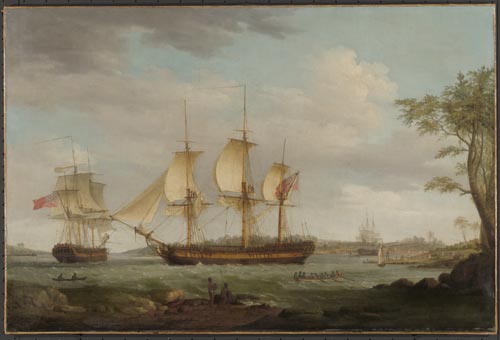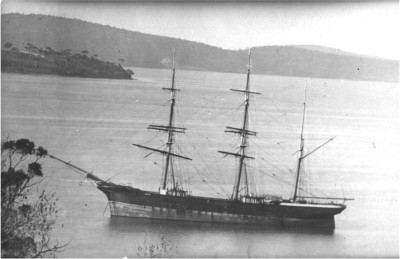Australia's Whaling History
Sydney Cove
It was 1791 and the new settlement, at Sydney Cove, posed a number of problems. The first and most pressing was food. The country offered very little, the most useful being hauls of fish. But these could not be relied on, sometimes they were plentiful, sometimes the nets came up empty. The British ship 'Emilia' was known to be hunting Sperm whales in the Tasman Sea as early as 1788.

The Britannia [Photo: The Encyclopaedia of New Zealand © Copyright] |
Within 4 years ships from England and America were sailing into Port Jackson eager to trade with the developing colony. In his voyage of 1791 Captain Melville of the 'Britannia' was struck by the possibility of fishing off the South coast of New South Wales. "When sailing up the coast within 3 leagues of the shore, I saw more whales at one time around my ship than in the whole of the six years which I have fished the coast of Brazil," he reported. He and other captains, as soon as their ships were cleared, set off to reap this sea harvest.
As early as 1792 Sydney Cove was the centre for the profitable whale and seal trade around the southern coasts. Under Governor King, if not necessarily because of him, the colony made great strides. Whaling brought profit to its shores, for the ships came into Sydney to refit. King referred to whaling as the only "staple" and saw visions of secondary profits. The American whalers provided a market for foodstuffs, water, timber, and anything else there might be for sale, including sovereigns to make themselves ear-rings in true piratical style. By 1795 reports of seals, sea elephants and whales in their thousands drew many whalers and sealers into southern waters, the Bass Straight.
By 1799 Australia was becoming useful as a source of Britain's raw materials, wool from the land, and whale oil from the sea. Soon, London was unloading 300 tons of sperm oil fished off the coast of New South Wales.
Bull Sperm Whale
The whales taken in Australian waters were enormous, the bull Sperm whale sometimes measuring as much as 22 metres in length. Whale blubber, when melted down, produced a fatty oil which was burnt in the lamps of London and New York, and for spermaceti for candles, and there were various other by-products. Another article of trade to draw ships from England and America were the fur-seals, their skins being sold as far afield as China.
The first merchant to export whale products from Sydney was Robert Campbell. Campbell, a scottish merchant, arrived in Sydney in June 1798 hoping to find opportunities for trade. He challenged the monopoly of the New South Wales Corps and traded at reasonable prices. By 1803 he had built a storehouse, a large residence and a wharf, known as Campbell's Wharf.
By 1804 there were nine London whalers appearing in the Antipodes with cargoes with an estimated value of 121,000 pounds. A settlement in Tasmania was now established and sealers and whaleboats began calling in on the new settlement on the Derwent river. The Tasmanian whaling industry centered on Hobart Town and the islands in Bass Strait, where far from authority, the whalers set up barbaric and primitive states, whaling in the season and cultivating the land in the off season.
By 1806 a cheap method of bay whaling had been developed. This meant that a small ship could harpoon a whale off the coast and tow it to a station on land. One station could therefore serve many ships. The first shore whaling station was established by William Collins in Ralph Bay on the Derwent river. Whalers hunted the female Southern Right whale which enters bays and estuaries to give birth. Whalebone was sought for corsets, as ribs for umbrellas and as hoops for skirts. In the years that followed, shore whaling stations dotted the Tasmanian coast and spread from Eden in New South Wales to Western Australia.
An Unregulated Industry
The whaling and sealing industry was quite unregulated, with the result that by the early 1800's whales and seals were well-nigh exterminated. Governor King recognised that this uncontrolled slaughter would ruin the industry and in May 1803 he was writing to Nepean:
- "Although a vast quantity of Sea Elephants and Seals have been taken and still abound about Hunters Island and Kings Island, yet from the different communications I have received I shall find it expedient to restrain individuals from resorting there in too great numbers, and to fix certain times for their visiting these places, to prevent the destruction of that commercial advantage. Since I took command 16,000 gallons of oil and 27,800 seal skins have been imported from thence by individuals, 1,063 tuns of spermaceti oil have also been procured by the south whalers, all which I need not point out as a rising nursery for Seamen."
By 1828 Sydney was setting itself up as an oil port but because of the noise and smells of boiling down the blubber and coopering from Sydney Cove Governor Darling ordered the whalers to keep to remote coves on the north shore.
In response to pressure, whaling allotments, with a waterfront, were made available for the whalers. The grants to Mosman and Bell were in Great Sirius Cove now Mosman Bay. Mosman's four acres included the site of the present ferry wharf and adjoining Bell's four acres which extended south along the foreshore. Mosman subsequently bought Bells's grant and then added to his establishment untill it aggregated 108 acres and extended up to what is now known as Military Road. There were now at least 21 whalers based in Sydney.
On and about 1833 the establishment in Mosman Bay became the scene of great activity. Seal and whale products formed Australia's main exports although wool sales overseas were increasing.
The years 1836 to 1841 marked the peak of the Tasmanian whaling industry, and in 1836 there were 9 stations in and about Hobart. By 1841 thirty-five bay whaling stations in Tasmania were manned by more than 1000 men but prosperity from the sea was almost exhausted. The seals had dissappeared and so had the black whales.
Victoria & New Zealand
If the settlement of New South Wales was achieved in a systematic and orderly fashion, other settlements were not. 1834 saw the first permanant settler in Victoria. He was Edward Henty and he agreed to start a settlement at Portland Bay. On arrival he was surprised to meet William Dutton who ran a seasonal whale station there since 1829. The white settlement of New Zealand was chaotic. It started in 1839 and the first settlers were itinerants who stopped briefly to set up camp while whaling, sealing or timber gathering. By 1840 there were 300 American whaling vessels working off the Western Australian coast.

The Barque Helen at anchor [Photo: State Library of Tasmania] |
In the ten years between 1832 and 1841 New South Wales exported whale products worth nearly two million pounds. There were no problems regarding the transportation of Sperm oil since it never left the hold of the ships that would sail it back to the home country.
A Doomed Industry
In the 1850's the demand for whale oil dropped and hunting focused on whales that offered whalebone. Tasmanian whaling continued into the 1880's and finally expired when the barque Helen paid off her crew in 1893. Throughout the nineteenth century a number of explorers and traders (notably sealers and whalers) penetrated the Antarctic Circle and explored the coastline.
Whaling and sealing brought a boom of sorts to the early colonies, but, owing to the hazards of the sea, the uncertainty of markets, the uncontrolled and uneconomic plundering of the fishing grounds, the 'poaching' of the Americans and the tarriff barriers in the English market, it was an uncertain and doomed industry.